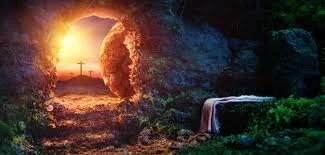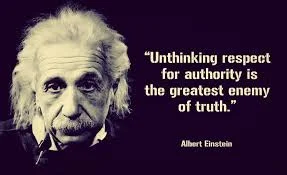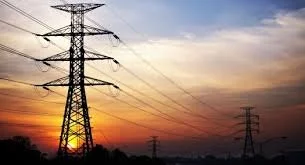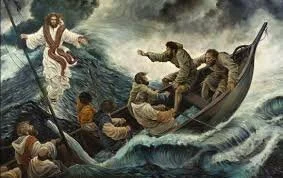Why body and blood?
Why not elbow and knee? Why not neck and nose?
Why two items? Why not one or more than two?
Jesus's choice of body and blood was not accidental.
There is a connection between his body and his blood. What is the connection? The wounds we opened with lash, thorns, nails and spear connect his body to his blood.
His bloody wounds are the mouth of God. They speak to us. The language uttered through the mouth of God consists of that which passed through them and that which did not. By that which passed through them and that which did not, God revealed his identity to us. Only by that which passed through his bloody wounds and that which did not, do we get a fair and accurate representation of God - a high fidelity, first class representation of God far superior to any representation of God made by human hands. In that passed through his bloody wounds and that which did not, the mouth of God gave us his autobiography. God poured more and better theology into his bloody wounds than into the heads of every apologist, theologian, Doctor of the Church, apostle, monk, abbot, mystic, priest, monsignor, bishop, Cardinal, Pope, hermit and saint who has ever lived or will ever live. Buckets of blood poured through the bloody wounds we opened in his body. On this cataract of blood, his very life itself was carried from his body. Yet, not a drop - not a drop - of his love for us followed the buckets of blood through the wounds. His most sacred heart stayed filled to the brim with love for us. He clung to his love for us, held tight and refused to let go. He clung with the iron grip of the drowning man tossed into the stormy sea after his ship is sunk.
His bloody wounds have two sides: 1) a near side and 2) a far side.
On the near side of his bloody wounds is his ignominious defeat. On the near side is found the Crucifixion. Unlike the mighty God of the Jews who freed his people from the Egyptians, this puny god of the new Testament failed to free his people from the Romans. The Romans defeated him. He was a loser. The Romans impaled him on a cross like a worm on a hook.
The connection between the Crucifixion and the Resurrection is his bloody wounds. As we pierced his body with bloody wounds, we pierced the veil between heaven and earth. The bloody wounds are a telescope through which we catch a glimpse of heaven from here on earth. When we look at them, we see the test into which we baptized him. When we look through them, we see the results of the test. The results of the test are the good news of great joy. Given the difficulty of the test, the results are very good news for us indeed.
On the far side of his bloody wounds is his glorious victory. On the far side of his bloody wounds is the Resurrection. The tyrant against whom the Son of God descended from heaven to earth to do battle was neither the Romans nor the Egyptians. The Son of God did not come to free us from either of these two tyrants. He had a bigger fish to fry. He came to free us from a far worse tyrant who has the power to transmogrify us into the most hideous and miserable of loveless beasts. This evil tyrant is within us. He instructs us, when our crosses try to bury us under their oppressive weight, to release our grip on love - to let love slip from our hearts. Without love, however, we lose any resemblance that we bear to God. Therefore, this natural human tendency must be denied. Only by denying ourselves, can we pick up and carry our crosses as we make progress through the valley of tears. Only love gives us the strength to do so.
We tortured and killed him. He suffered and died. Yet, he did not stay dead and he did not stop loving us. He emerged from the dead sill alive and sill in love with us.
That he did not stay dead is the proof that Jesus is omnipotent. Nobody emerges alive from the dead. He did.
That he did not stop loving us, however, is the proof that our conception of divinity as omnipotence is incomplete. Divinity is more than omnipotence. Divinity is also love.
The dial that controls his love for us is in his hands not ours. Moreover, it is set to the highest degree and is locked in place.
The Crucifixion, Resurrection and the connection between them constitute the Autobiography of God. The Autobiography was not written in words but was done in deeds. What do we learn from reading God's autobiography? We learn that the evil we did to him did not extinguish the bonfire of love that burns for us in his most sacred heart or reduce it by even the slightest degree.
In fact, God is head over heels in love with us.
We get a sense of the magnitude of his love for us by the price he paid to produce the Crucifixion. He paid the price not from his unlimited divine resources. He paid the price from his limited human resources. He paid them all for us. He kept not a penny for himself. He has never paid more for anything else.
We get a sense of the duration of his love for us from its indestructibility. His love for us ought to have faded as we tortured him and ought to have died when we killed him. But it did not. His love for us survived. Its survival is the proof that the duration of his love for us is forever.
That the evil we did to him did not adversely affect his love for us tells us without any ambiguity whatsoever that nothing can.
His love for us is the rock on which we can build our faith.
Therefore, when you behold the most Holy Eucharist, do not just say, 'Look, there is the Son of God'. This misses the point by a mile. When you behold the most Holy Eucharist, joyously exclaim, 'Look, there is the Son of God and he carries his bloody wounds with him.' In the bloody wounds is the meaning of everything
.A Jesus without his bloody wounds is just omnipotence. Omnipotence is neutral - salt without its flavor (Matthew 5:13). Omnipotence demands respect nothing more.
A Jesus with his bloody wounds is so much more. His bloody wounds are the visible tokens of his love for us. His love for us makes his omnipotence sweet. His love for us is the honey that draws the bees back home to the hive.
Omnipotence demands respect. But, love demands love.
P.S. God instituted the sacrament of the most Holy Eucharist and not Eucharistic Adoration because he wanted the children of Adam and Eve to focus on the meaning of his bloody wounds and not merely on his real presence. In Eucharistic Adoration there is a risk of focusing on the real presence at the expense of focusing on his bloody wounds. The risk has been realized because the conversation ignores the bloody wounds.

























The sourness of godlessness vaccinates us against the illusion conjured up by the serpent that a life lived as gods in godlessness is better than a life lived with God in paradise. It is harsh but effective medicine. God mitigates its harshness by making our lives in godlessness brief. The brevity of life is proof of a merciful God.